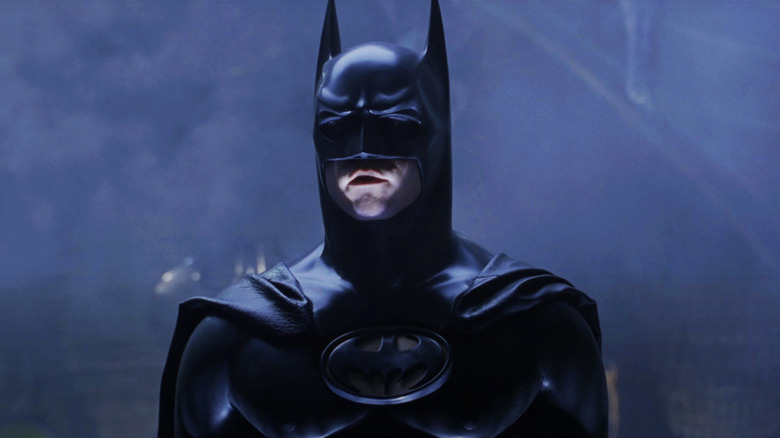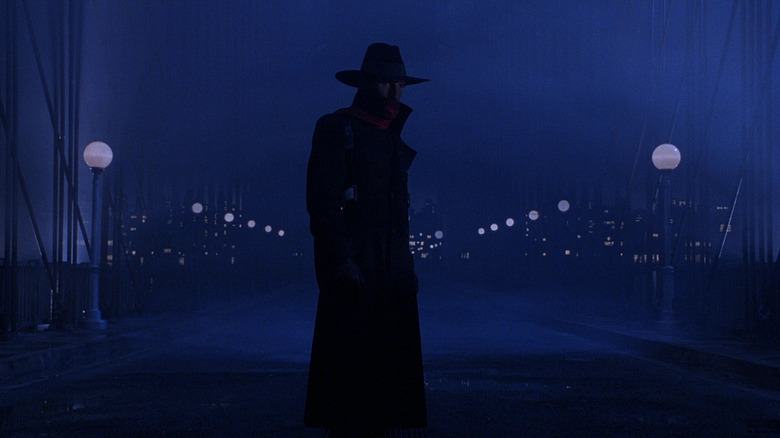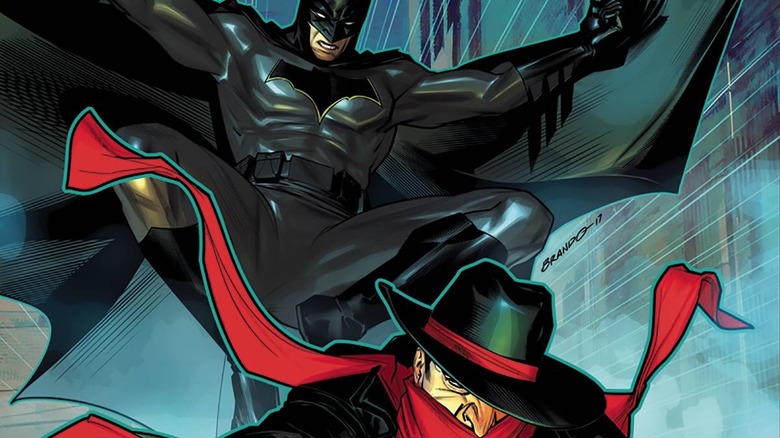One Of Batman's Uneasiest Allies Is A Character He Originally Plagiarized
We may receive a commission on purchases made from links.
When it comes to heroes who are cloaked in darkness and use fear and intimidation to spook their enemies, Batman leads the charge. After all, the Dark Knight has been protecting Gotham City for almost 90 years and has more than established himself as one of the world's most popular superheroes in that time. However, Batman wasn't the first hero to boast the aforementioned hallmarks — and some folks might argue that he ripped off the pulp hero known as The Shadow, aka the man who knows what evil lurks in the hearts of men.
The Shadow began life as a radio host in 1930, providing the voiceovers for a program called "Detective Story Hour." However, the mysterious character proved to be more popular than the stories being told on the air, so the bosses at publisher Street & Smith hired William B. Gibson to pen some crime, mystery, horror, and adventure tales centered around the Shadow. As his name suggests, the hero has a knack for hiding in dark corners and being practically invisible, which comes in handy for taking down the various threats he goes up against. Sound familiar?
The Shadow has remained a pop culture cornerstone throughout the years — not to mention the star of numerous books, comics, and radio dramas. And let's not forget about the 1994 movie starring Alec Baldwin, which ironically exists due to the box office success of Tim Burton's "Batman" and the wave of lower-grossing '90s pulp adaptations that followed in its wake. Not only that, but the Shadow is also regarded as one of the earliest influences on the superhero genre — and he even teamed up with one of the caped crusaders he inspired the most. Before we get into that, though, let's discuss how Batman plagiarized The Shadow early on.
How Batman ripped off The Shadow
Batman was influenced by Dracula and lots of things, but The Shadow's DNA is all over his early stories. Before Batman carried a Batarang and flew a Batgyro, the Shadow used boomerangs and flew autogyros. Once upon a time, Batman also carried a .45 pistol, which is the same gun the Shadow used back in the day. 1939's "Death's Harlequin" story even has the Shadow battling a murderous clown with a fiendish laugh, much like The Joker after him. Not to mention, the Shadow is known as the Knight of Darkness, which is similar to one of Batman's most famous nicknames.
The coincidences don't end there, but the plagiarism is evident in Batman's comic book debut, "The Case of the Chemical Syndicate," which copies the Shadow's "Partners in Peril." Both tales center around chemical corporations and feature scenes in which their heroes use handkerchiefs to stop poisonous gases from spreading, as well as mentions of their protagonists being bat-like. Batman's original creators fully acknowledged the similarities as well, with Bill Finger having once described "The Case of the Chemical Syndicate" as a riff on the aforementioned "Shadow" adventure.
Elsewhere, Bruce Wayne's rich-guy socialite personality is reminiscent of the Shadow's Lamont Cranston alter-ego. While he didn't mention this specific persona as an influence on Bruce, "Batman" co-creator Bob Kane admitted that the Shadow inspired his character's secret lifestyle. As he recalled in Will Murray's "Master of Mystery: The Rise of The Shadow" book:
"I suppose both The Shadow's cloaked costume and double-identity role, as well as the acrobatics of Douglas Fairbanks, Sr., did more to create the character and personality of Batman than any other factors."
In the spirit of fun, however, the "Batman" franchise has seemingly acknowledged its plagiarized roots, as "Partners in Peril" is the title of an episode of "The Adventures of Batman" and a 1996 video game. What's more, both characters have learned how to co-exist and stand out as separate entities.
Batman and The Shadow have a complicated history
Batman has teamed up with the Teenage Mutant Ninja Turtles and other unlikely heroes, so having him join forces with the character who inspired his creation isn't the wildest concept to believe. When DC Comics published its own "The Shadow" comics in the 1970s, it even brought the Knight of Darkness into contact with The Dark Knight in "Batman" #253 and #259, respectively.
In Dennis O'Neil's and Irv Novick's first tale, an aging Lamont Cranston passes the torch to Bruce Wayne after making sure he's up to the task of fighting crime — which requires Gotham's hero to bust a counterfeiting ring. The second story, meanwhile, sees them team up to stop a robber who's just been released from prison and wants to kill Batman and the Shadow. In short, the latter stopped the thief from killing a young Bruce Wayne and other innocents years before, and the baddie wants revenge.
The original Batman and Shadow team-up adventures gives them an alliance built on respect, but subsequent stories portray them as uneasy allies. In Scott Snyder and Steve Orlando's "Batman/The Shadow: The Murder Geniuses," for example, the Dark Knight suspects that his counterpart is a killer, which causes some tension before they join forces to find the real culprits. This theme is continued in Orlando and Giovanni Timpano's "Batman/The Shadow," but our heroes are forced to put their differences aside to prevent Shiwan Khan, Ra's al Ghul, and the Silent Seven from causing havoc.
These days, Batman is more popular than the Shadow, but it is good to see comic books honor the latter's influence on Gotham's Dark Knight. That said, maybe it's time for Hollywood to finally let Sami Raimi direct that "Shadow" movie he's been longing to make for years — maybe then, the Knight of Darkness will gain the widespread recognition he deserves in modern times.


